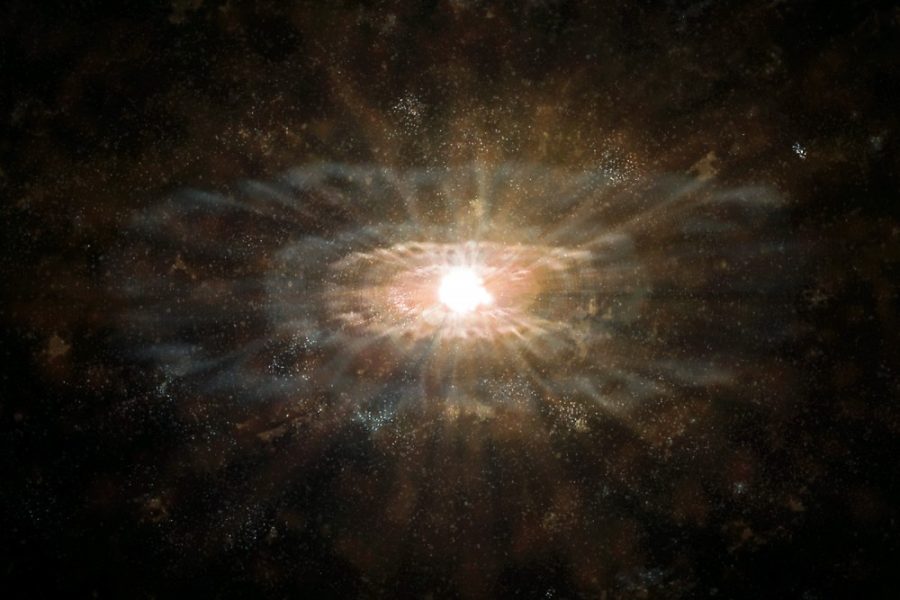Imagine this: You are sitting at your desk late one night, working on a theory that could help explain how the universe expanded so fast that light couldn’t keep up with it. You name your theory “inflation” and wait, hoping that one day evidence will be found to support your grand idea.
Now, imagine that, 40 years later, a team of scientists finds evidence that the idea you scratched into your notebook might actually be true.
That is precisely what happened to Alan Guth, a physicist and professor at Massachusetts Institute of Technology, who was one of the first people to hypothesize the theory of inflation in the 1980s, which accounts for the rapid expansion of the universe in the trillionth of a trillionth of a trillionth of a second following the Big Bang. Inflation theorizes that because space would have expanded faster than the speed of light, it would have left behind evidence of its rapid expansion.
According to The New York Times, a team of scientists led by John M. Kovac of the Harvard-Smithsonian Center for Astrophysics and stationed at the South Pole telescope, Bicep2, has detected ripples in space that are traceable to the beginning of time. This serves as evidence that Guth’s theory of inflation is correct.
Approximately 13.8 billion years ago, the universe exploded into existence in an event known as the Big Bang. Since that time, the universe has continued to expand and develop, cooling and forming new structures as it spreads out over space-time. However, this explosion in the early universe left behind energy, known as cosmic background radiation.
According to Don McCarthy, an astronomer at the UA’s Steward Observatory, as the early universe cooled, hydrogen atoms were formed. These atoms had a very weak interaction with the cosmic background radiation, allowing the radiation to expand and fill the volume of space.
The team at the South Pole looked at the microwaves left over from the Big Bang for signs of gravitational waves, which are ripples in the space-time of the universe. The theory of inflation holds that these gravitational waves formed as the universe was ripped apart due to rapid, violent expansion.
“As people started working with the theory of inflation, they realized that the inflationary situation would have been rich with gravity waves because space-time is changing in such a dynamic way,” said Chris Impey, a UA distinguished professor and deputy head of the astronomy department.
Because scientists have no way of directly detecting these gravity waves, they instead had to look for spiral patterns and polarization in the microwaves to determine their existence, Impey said.
Along with the observations of the microwaves and the presence of gravity waves, the theory of inflation has also garnered widespread support in the scientific community because it can explain the uniform “smoothness” of shape and temperature in the universe after the Big Bang, McCarthy said.
What has puzzled scientists about the Big Bang is that it does not explain why separate parts of the universe that are not in communication with each other have the same uniform shape. Also confusing is the fact that, although the temperature shouldn’t have been able to even out, it is relatively uniform throughout space. So instead of endless variation, our universe is flat, and the temperature is almost the same at every point in the cosmos, regardless of how far away each patch of space is from the other.
“It’s like if everyone showed up to take the SAT wearing exactly the same clothes and got exactly the same score — they must have talked to each other beforehand,” said McCarthy of our universe’s uniformity.
Inflation provides a relatively simple explanation for these confounding characteristics, McCarthy said. The theory states that the universe expanded faster than the speed of light, and the objects we observe now as separate were actually once together for a fraction of a second before being blown apart during inflation, allowing for uniform dispersion.
“For a very, very short instance, every part of the universe knew about every other part of the universe,” says Rodger Thompson, a professor in the department of astronomy. Because inflation posits that these seemingly separate areas of space were once in communication with one another, the theory explains some of the only issues the Big Bang model does not account for, Thompson says.
While the evidence from the South Pole is enormously significant for the theory of inflation, more research still needs to be done before a definitive conclusion is made. However, many scientists view the research as comparable in significance to that of the Higgs boson or the discovery of cosmic background radiation. Scientists, including Impey, also believe that the research could earn Guth and Kovac a Nobel Prize in physics.
“[This discovery] is dramatic, because it means we can make physical theories about the universe that have validity back to this tiny instant of time,” said Impey. “It’s an example of the phenomenal power of theories when they are successful.”
—Follow Michaela Kane @MichaelaLKane









